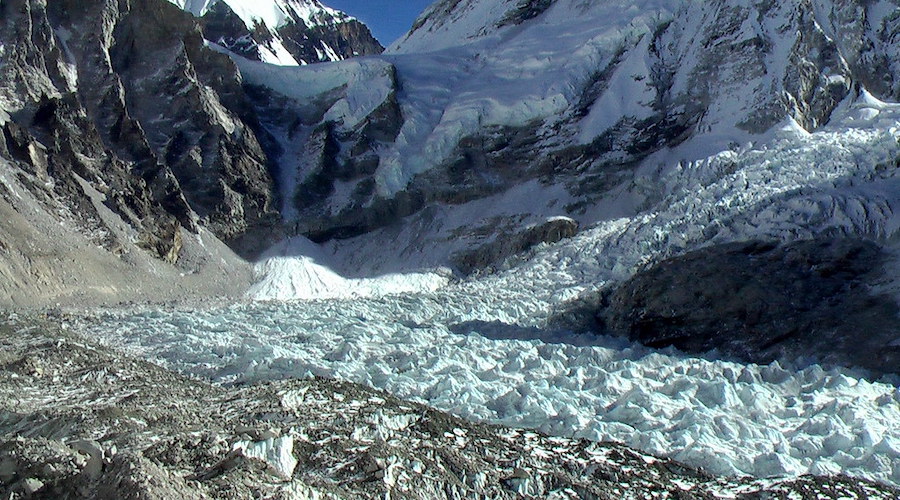Global S&T Development Trend Analysis Platform of Resources and Environment
| Metal pollution, tourism threaten drinking water around Mount Everest | |
| admin | |
| 2021-07-12 | |
| 发布年 | 2021 |
| 语种 | 英语 |
| 国家 | 国际 |
| 领域 | 地球科学 |
| 正文(英文) |  Khumbu Glacier, Everest Base Camp, Nepal. (Image by Rick McCharles, Flickr).
New research published in the journal Science of the Total Environment, reveals that wind-transported metal pollution from mining paired with activities linked to the tourism industry is threatening drinking water around Mount Everest. According to the study, there is particular concern regarding the health of the over 3,500 residents and several thousand seasonal climbers who depend on the Khumbu Glacier melt for drinking water and irrigation. This is because precipitation and melt can contain toxic substances which means that as snow and glaciers melt, entrapped chemicals are released. Local pollution sources include aviation fuel for helicopters, generators, batteries and incinerators, as well as human waste at Everest Base Camp. Distant pollution sources, on the other hand, include mining, metal smelting, oil, and coal combustion.  In the paper, lead author Heather Clifford, a doctoral student in the Climate Change Institute at the University of Maine, explained that long-range transport and deposition of aerosols in the Himalayas are strongly influenced by the seasonal migration of the South Asian monsoon that, along with westerly winds, transport these chemicals. According to Clifford, while heavy metals occur naturally in the environment, human activity results in significantly higher levels in the atmosphere, which can negatively impact human and ecosystem health. “Further spatial environmental monitoring, specifically looking into the chemical and biological makeup of the streams, could help to assess health impacts, water quality and potential sources of heavy metals,” the scientist said in a media statement. To carry on her research, Clifford analyzed the chemical composition of pre-monsoon samples of stream water at 4,300–5,250 meters and snow at 5,200–6,665 meters from Mount Everest, Mount Lobuche, and the Imja Valley, in addition to a shallow ice core recovered from the Khumbu Glacier at 5,300 meters. “Pre-monsoon aerosol deposition is dominated by dust originating from western sources and less frequently by transport from southerly air mass sources as demonstrated by evidence of one of the strongest recorded pre-monsoon events emanating from the Bay of Bengal, Cyclone Fani,” the study reads. “Elevated concentrations of human-sourced metals (e.g., Pb, Bi, As) are found in surface snow and stream chemistry collected in the Khumbu region.” Following her analyses, the scientist suggests it is important to start measuring lead, bismuth, and other trace elements in the atmosphere and snow so that it is possible to fingerprint the sources of the human pollutants. In Clifford’s view, this is the first analysis of its kind on Khumbu Glacier ice and the first detailed characterization of pre-monsoon snow/water elemental chemistry for the region.
|
| URL | 查看原文 |
| 来源平台 | Minging.com |
| 文献类型 | 新闻 |
| 条目标识符 | http://119.78.100.173/C666/handle/2XK7JSWQ/331132 |
| 专题 | 地球科学 |
| 推荐引用方式 GB/T 7714 | admin. Metal pollution, tourism threaten drinking water around Mount Everest. 2021. |
| 条目包含的文件 | 条目无相关文件。 | |||||
| 个性服务 |
| 推荐该条目 |
| 保存到收藏夹 |
| 查看访问统计 |
| 导出为Endnote文件 |
| 谷歌学术 |
| 谷歌学术中相似的文章 |
| [admin]的文章 |
| 百度学术 |
| 百度学术中相似的文章 |
| [admin]的文章 |
| 必应学术 |
| 必应学术中相似的文章 |
| [admin]的文章 |
| 相关权益政策 |
| 暂无数据 |
| 收藏/分享 |
除非特别说明,本系统中所有内容都受版权保护,并保留所有权利。
修改评论